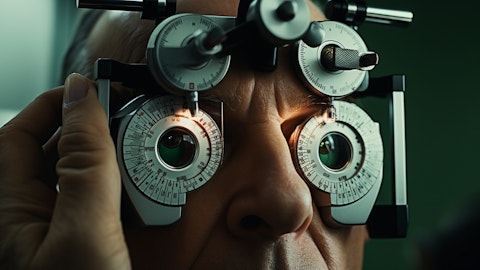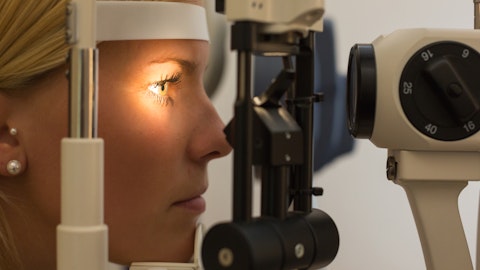Shelley Thunen: Yes, qualitatively, of course, the LAL grows much faster than the LDD, and that’s to be expected, because our primary focus is not only just getting new customers, but getting new customers up faster, as well as continuing to penetrate in our existing customers and get them to continue to grow. So we have seen this shift between the LAL and LDD. The more installed base you get, you continue to get that. But in terms of breaking it out, I think kind of the general trends that we’ve been in for the last three or four years with LALs increasing much faster than LDD is indicative of what we want to do.
Patrick Wood: Makes sense. Thank you. And then again, qualitatively, all the LDD placements that you’ve seen in the last three, four, five months outside of things, could you give us some sort of flavor? How much of that is new accounts, existing accounts, buying a second system, just how that’s trended over time very recently would be helpful.
Shelley Thunen: Yes, it’s predominantly new accounts. And what you see now a little bit is, I wouldn’t call them repeat accounts in the following sense, because each sale is to an individual office, although the doctor or the underlying owners may be the same, right. Because you’re still selling to the primary doctors in the practice that want to pick up the LAL. Some doctors have two or three separate offices. They start in one, but then they might have different partners in their second and third offices. We see other people that are part of a larger network or buying group, but each of those are individual sales. But I would say the vast majority are brand new customers to us that we haven’t had in our installed base. There always are some that by that we know, and they’re really just expanding their footprint in their practices or in their network.
Patrick Wood: Brilliant. Thank you so much.
Operator: Thank you. [Operator Instructions] And our next question is going to come from the line of David Saxon with Needham & Company. Your line is open. Please go ahead.
Joseph Conway: Hi, this is Joseph on for David. Just wanting to know how you guys are thinking about the competitive landscape with Odyssey and kind of an early launch and PanOptix Pro coming in the future.
Ron Kurtz: Well, thank you. I would categorize those competitive offerings as being part of the fixed lenses that very similar to other fixed lenses in the marketplace. And so while they may gain some attention at the end of the day, they’re going to be compared against those more similar products than, say, the light adjustable lens. So we expect that the market will continue to see new offerings, but that the LAL will continue to have a unique set of benefits for patients.
Joseph Conway: Okay, got you. And then maybe just a quick one, can you give some color around balance sheet and how you guys are thinking about runway to free cash flow profitability?
Shelley Thunen: Yes. I think that what you have seen is reduced cash use in each quarter as we’ve increased both revenue and gross margin. What you did see in this guidance is that we had a pretty big increase in our guidance for gross margin, but we also did increase OpEx a bit. And I think the increase in gross margin business an opportunity. We let most of those dollars fall to the bottom line, but we will continue to continue this balance between growth and gross margin in percent and absolute dollars with continued investment in OpEx. But I think we’ve been very careful in this guidance balance both.
Joseph Conway: Okay, sure. Thank you very much for taking our questions.
Shelley Thunen: Thank you.
Operator: Thank you. [Operator Instructions] And our next question is going to come from the line of Tom Stephan with Stifel. Your line is open. Please go ahead.
Tom Stephan: Great. Hi, everyone. Thanks for taking the questions. Maybe I’ll start with LAL Plus. Could you maybe, I guess, qualitatively explain a bit how LAL Plus was contemplated in 2024 guidance? Maybe in terms of the cadence of the rollout. I guess, in other words, does guidance assume kind of a methodical ramp of LAL Plus? Is it a fast ramp up maybe somewhere in between? Any color there would be helpful.
Shelley Thunen: Okay. In terms of mix between the LAL and LAL Plus, they’re priced at the same amount at $1,000 per unit, right. And I think that for us and Ron can comment on this a little bit more. Part of the pricing strategy, of course, is that we want the doctor and patient to pick the ideal lens for them, knowing that both are adjustable. And we think that the results that we had in the first quarter are part of just our original guidance or strategy for the year with this concept of having two LALs in our product family overall. I don’t know if you would comment anything additional on that, Ron?
Ron Kurtz: No. I mean, recall that the LAL Plus was approved in 2023, and it was, we had some initiated some initial Phase 4 clinical studies in the fall. So we certainly had that in our minds, developing 2024 guidance.
Tom Stephan: Got it. That’s helpful. And then just my follow-up, I guess, on gross margin. Shelley, can you maybe level set us on where gross margin stand between your different products? Because when I run a low 30% gross margin on the LDD sales, I’m arriving at maybe 85% plus gross margin on the rest of the business. Are those fair places to be on both sides? And I guess I’m mainly curious about where LAL gross margin is tracking toward. Thanks.
Shelley Thunen: Yes. Well, we don’t break out both of them. Certainly, we’ve provided some information overall. As I’ve always stated, our gross margin on the LDD, this piece of capital equipment we try and get between 20% and 30%. As you go back into early 2023, we were below the 20% or right at. Today, we are above the 30% and what I would call well above overall. And just this little $3,000 higher ASP in the first quarter contributed to about a 2 percentage point increase in gross margin for the LDD. So we’re trending a bit higher than we would otherwise. And I contribute that to one a good pricing ASP discipline on the – with our sales force, the value of the product, as well as the fact that we were able to roll in some lower material costs a little bit earlier.
On the LAL side, we don’t comment, but we believe that product is, in this kind of range, in the 80% something range, and probably likely over a very long time to begin a 90% product. But that’s a kind of way out there. You got to get your volumes up for that to happen.
Tom Stephan: That’s great. Thanks, Shelley. Thanks, Ron.
Ron Kurtz: Thank you.
Operator: Thank you. And one moment for our next question. And our next question is going to come from the line of Larry Biegelsen with Wells Fargo. Your line is open. Please go ahead.




